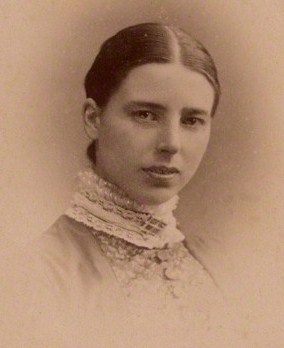Catherine Courtney, Baroness Courtney of Penwith facts for kids
Quick facts for kids
The Lady Courtney of Penwith
|
|
|---|---|

Catherine Courtney in 1883
|
|
| Born |
Catherine Potter
4 April 1847 |
| Died | 26 February 1929 (aged 81) Chelsea, London, England
|
| Nationality | English |
| Other names | Kate Courtney |
| Occupation | Social worker |
| Known for | Activism |
| Spouse(s) | Leonard Courtney |
| Parent(s) | Richard Potter Laurencina Heyworth |
Catherine Courtney, Baroness Courtney of Penwith (born Potter; 4 April 1847 – 26 February 1929), also known as Kate Courtney, was a British social worker and someone who worked for peace around the world. In her younger years, she was active in groups that helped people. Later, she and her husband, Leonard Courtney, campaigned to end the Second Boer War and the First World War. She tried to show how people in enemy countries were suffering. During both wars, some people criticized her for being too kind to the enemy.
Contents
Early Life of Catherine Courtney
Catherine Potter was born at Gayton Hall in Herefordshire, England. She was the second daughter of Richard Potter, a businessman, and his wife Lawrencina. Her seven younger sisters included Beatrice Webb, who became a famous social reformer.
Catherine was mostly taught at home by tutors. For a short time in the 1860s, she went to a girls' boarding school in London. She was not seen as especially smart or beautiful. She also really disliked formal social events for the upper class. After her "coming out" party in 1865, she wanted to be independent. She did not want her parents to arrange a marriage for her.
Helping People in London
In 1875, when Kate Potter was 28, she left her family home. She moved to London to work with Octavia Hill, a social reformer. Kate started training with the Charity Organization Society in Whitechapel. She also helped organize boys' clubs in the East End of London. Later, she joined Samuel Augustus and Henrietta Barnett in their charity work.
Her parents and older sister did not approve of her choice. But they eventually gave her a small allowance. This allowed her to live in Great College Street in Westminster. She stayed in touch with her family. They often complained about her making them go to "poor people's parties."
For eight years, from 1876 to 1883, she worked at St Jude's Church, Whitechapel. As Octavia Hill's full-time helper, Kate Potter's jobs included running youth clubs and collecting rent. Her busy work schedule helped her avoid her family's expectations. She was friendly, which made her popular even as a rent collector. She even convinced her sisters Theresa and Beatrice to join her. In 1884, some model homes in Aldgate where she worked were named after her. They were called Katharine Buildings.
Marriage and Activism

Catherine Potter met Leonard Courtney in 1880. He was 48 years old and a Liberal government minister. They became friends at dinner parties hosted by Charles Booth. Potter and Courtney got married on 15 March 1883. Both were Quakers, a religious group. They had a happy marriage for 35 years.
Under her husband's influence, Catherine became a suffragist. This meant she supported women's right to vote. She also joined the Liberal Unionist political group. After marriage, she focused on her home and supporting her husband's work. In 1899, they started the South Africa Conciliation Committee. This group worked to end the Second Boer War.
In the 1890s, she became a leader in the Women's Liberal Unionist Association. But she was disappointed by its old-fashioned views and support for imperialism. She resigned from the group's committee in 1900. The Courtneys also strongly supported Harriette Colenso, who worked for the welfare of the Zulu people.
Working for Peace During Wars
The Courtneys actively worked for world peace. During the Second Boer War, some people accused them of being "pro-Boers" (meaning they supported the Boers). They even received anonymous threatening letters. After the First World War, the Daily Sketch newspaper called Catherine "pro-Hun" (meaning she supported the Germans).
She strongly supported negotiating to end both wars. In 1899, she joined Emily Hobhouse's campaign for an armistice (a ceasefire). Later, during the First World War, she worked with Jane Addams. They tried to arrange peace talks with the help of countries that were neutral (not taking sides).
In 1901, Catherine visited South Africa. She went there to report on the conditions inside the concentration camps built for Boer civilians. In 1906, her husband was given a special title, a peerage. This made her Baroness Courtney of Penwith.
During the First World War, Lady Courtney spoke up for the "innocent enemies." These were civilians from enemy countries. She helped start an emergency committee to assist German civilians living in Britain. She visited German prisoners of war and shared the work of her German helpers in Berlin. She tried to convince the Home Office (a government department) not to send German foreigners back to Germany, but she was not successful.
Later Life and Legacy
Lady Courtney's husband passed away in May 1918. In January of the next year, she hosted the first meeting of the Fight the Famine Committee at her home in Cheyne Walk. This committee later grew into the famous Save the Children Fund.
Along with her former brother-in-law, Lord Parmoor, Lady Courtney campaigned to end the blockade of Germany. A blockade stops goods from entering or leaving a country. In 1920, she wrote to The Daily News newspaper. She said that "somebody must begin to be good if the better world we were promised is ever to come."
Catherine Courtney died in Cheyne Walk in 1929. She was buried at Chelsea Old Church.
Images for kids
-
Catherine Courtney in 1898, by Sir John Benjamin Stone





